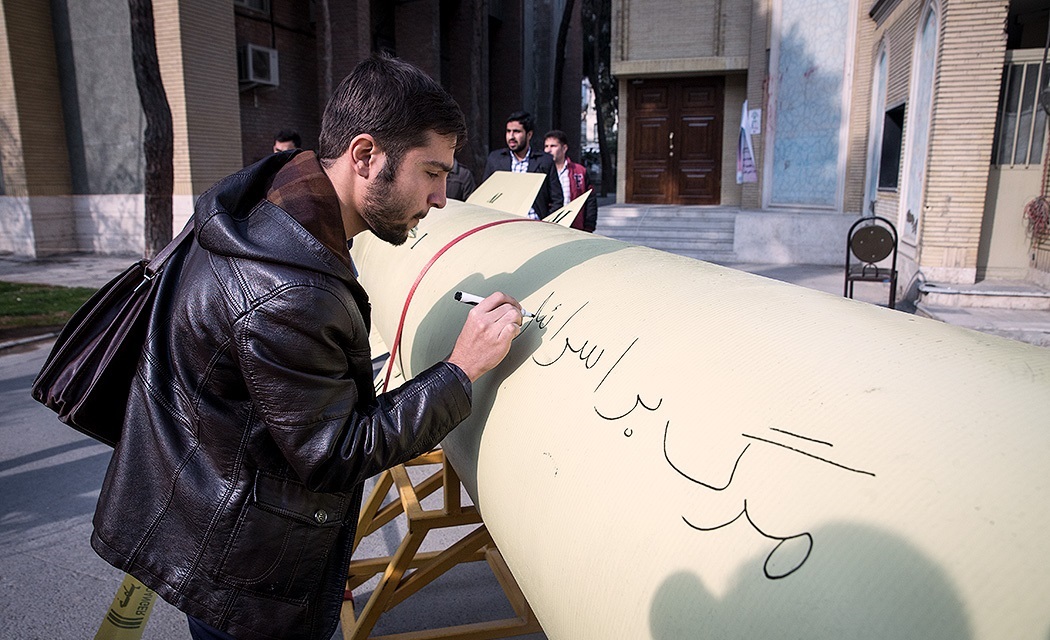Despite mounting pressure to reduce its ballistic missile program developments, Iran went public with its latest version of a short-range solid fuel ballistic missile known as Zolfaghar, putting it on temporary display in front of Amirkabir University of Technology in Tehran last week.
The Zolfaghar missile has a range of 700 to 750 km (435 – 466 mi) and belongs to Iran’s class of Fateh missiles, which its military says are highly accurate and can negate electronic waves used by enemy systems to divert the missiles from their targets. The missile measures 8.86 m (29 ft) long and has a diameter of 61 cm (24 in.), weighing 450 kg (992 lbs). According to officials, the missile cannot be detected by radar systems.
According to the Center for Strategic and International Studies' Missile Defense Project, the Zolfaghar packs a highly explosive warhead as well as sub-munitions that separate from the missile prior to impact.
Zolfagar missiles were used in June by the Islamic Revolutionary Guards Corps to destroy Islamic State (IS) targets in Dayr al-Zawr in Syria, resulting in the deaths of a senior IS commander and about 360 other terrorists.
The name of the missile which was unveiled by the Iranian Defense Ministry in 2016, is derived from the legendary sword of the first Imam in Shia Islam, Ali ibn Abi Talib, which is said to have been given to him by the Prophet Muhammad.
In June, the Iranian parliament announced that an additional $550 million will be allocated for expanding the country's missile activities, and the rest will be allocated to the Quds Force to increase its efforts in the fight against terrorist groups.
“Iran’s missiles exist with full force. And when needed, missile tests will be carried out. And if necessary, Iran will launch missile attacks as it did against the ISIS,” Deputy Foreign Minister of Iran Abbas Araghchi said on December 11, according to Fars.
Despite international pressure on Iran to curb its missile program, Iran continues to further develop its missile and overall defense capabilities.
On December 13, the UN Secretary-General Antonio Guterres said that Iran’s actions may be defying a UN call to halt ballistic missile development, even as Iran complies with the nuclear deal agreed to with six world powers that was signed in July 2015.
The Trump administration accuses Tehran of violating the “spirit” of the nuclear deal pointing to its continued tests of ballistic missiles. In August, Trump signed a bill passed by the U.S. Congress to impose a new round of sanctions related to Iran’s ballistic missile program. In February, the U.S. had imposed sanctions on additional Iranian entities, after Iran test-fired a ballistic missile one month earlier.
Iran is also accused of transferring ballistic missiles to Houthi rebels in Yemen that may have been used in launches aimed at Saudi Arabia, in July and again in November.
“If we have kept the range of our missiles up to 2,000 kilometers and have not increased it, it is not because of technological limitations. This is because we have a strategic doctrine for the range of our missiles. Therefore, the Europeans should know that if they threaten us, we will increase the range of our missiles,” the deputy IRGC Commander, Brigadier General Hossein Salami said on November 26, according Iran’s Tasnim news agency.







 President Ilham Aliyev shed light on the evolving contours of the peace process with Armenia during an international conference in Baku this week. ...
President Ilham Aliyev shed light on the evolving contours of the peace process with Armenia during an international conference in Baku this week. ...
 Azerbaijan and Armenia started the process of demarcation of their border on Tuesday, with the installation of the first border markers based on ge...
Azerbaijan and Armenia started the process of demarcation of their border on Tuesday, with the installation of the first border markers based on ge...
 Armenian sappers commenced on Monday mine-clearance operations in the territories adjacent to the Saint Mary Church in village of Voskepar (Armenia...
Armenian sappers commenced on Monday mine-clearance operations in the territories adjacent to the Saint Mary Church in village of Voskepar (Armenia...
 Russian Foreign Minister Sergei Lavrov has reasserted that Moscow has no intentions to stop the fighting in Ukraine, even if peace talks commence.
Russian Foreign Minister Sergei Lavrov has reasserted that Moscow has no intentions to stop the fighting in Ukraine, even if peace talks commence.
 Iran and Pakistan have signed eight cooperation documents in various fields, and agreed to strengthen ties to fight terrorism in the region.
Iran and Pakistan have signed eight cooperation documents in various fields, and agreed to strengthen ties to fight terrorism in the region.
 President Aliyev emphasized the critical role of the North-South Transport Corridor in fostering transport cooperation between Azerbaijan and Russi...
President Aliyev emphasized the critical role of the North-South Transport Corridor in fostering transport cooperation between Azerbaijan and Russi...



